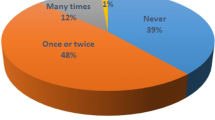Abstract
A questionnaire assessing beliefs and behaviors associated with cheating was administered to 365 college students. Circumstances rated most likely to increase cheating were low instructor vigilance, unfair exams, an instructor who does not care about cheating, and dependence of financial support and long-term goals on good grades. Circumstances rated most likely to decrease cheating were high instructor vigilance, fair exams, high punishment for getting caught, essay exams, widely spaced exam seating, and valuable course material. Principal components analyses revealed several factors underlying planned cheating: difficulty/negative consequences of cheating, pressures, instructor personality, social norms, and interest in the course. These factors relate to the determinants of behavior specified by the theory of planned behavior. Self-reports indicated that 83 percent of respondents cheated in college and that the two most common types of cheating were giving (58 percent) and getting (49 percent) exam questions to and from other students before an exam. Acts of helping someone else cheat were more commonly reported than corresponding acts of cheating for oneself. Students with high cheating scores tended to be male rather than female, to have a low goal grade-point average, and to believe that the prevalence of cheating in college is high.
Similar content being viewed by others
References
Aiken, L. R. (1991). Detecting, understanding, and controlling for cheating on tests.Research in Higher Education 32(6): 725–736.
Ajzen, I. (1985). From intentions to actions: A theory of planned behavior. In J. Kuhl and J. Beckmann (eds.),Action-Control: From Cognition to Behavior (pp. 11–39). Heidelberg: Springer.
Ajzen, I. (1991). The theory of planned behavior.Organizational Behavior and Human Decision Making Processes 50: 179–211.
Ajzen, I., and Madden, T. J. (1986). Prediction of goal-directed behavior: Attitudes, intentions, and perceived control.Journal of Experimental Social Psychology 22: 453–474.
Beck, L., and Ajzen, I. (1991). Predicting dishonest actions using the theory of planned behavior.Journal of Research in Personality 25: 285–301.
Calabrese, R. L., and Cochran, T. J. (1990). The relation of alienation to cheating among a sample of American adolescents.Journal of Research and Development in Education 23(2): 65–72.
Daniel, L. G., Blount, K. D., and Ferrell, C. M. (1991). Academic dishonesty among teacher education students: A descriptive-correlational study.Research in Higher Education 32(6): 703–724.
Davidson, A. R., and Morrison, D. M. (1983). Predicting contraceptive behavior from attitudes: A comparison of within-versus across-subjects procedures.Journal of Personality and Social Psychology 45(5): 997–1009.
Davis, S. F. (1993, March).Cheating in college is for a career: Academic dishonesty in the 1990s. Paper presented at the Annual Meeting of the SouthEastern Psychological Association, Atlanta, Georgia.
Davis, S. F., Grover, C. A., Becker, A. H., and McGregor, L. N. (1992). Academic dishonesty: Prevalence, determinants, techniques, and punishments.Teaching of Psychology 19(1): 16–20.
Haines, V. J., Diekhoff, G. M., LaBeff, E. E., and Clark, R. E. (1986). College cheating: Immaturity, lack of commitment, and the neutralizing attitude.Research in Higher Education 25(4): 342–354.
Houston, J. P. (1976). Amount and loci of classroom answer copying, spaced seating, and alternate test forms.Journal of Educational Psychology 68(6): 729–735.
Houston, J. P. (1983). Alternative test forms as a means of reducing multiple-choice answer copying in the classroom.Journal of Educational Psychology 75(4): 572–575.
Houston, J. P. (1986). Classroom answer copying: Roles of acquaintanceship and free versus assigned seating.Journal of Educational Psychology 78(3): 230–232.
Jendrek, M. P. (1992). Students' reactions to academic dishonesty.Journal of College Student Development 33: 260–273.
Keppel, G. (1991).Design and Analysis: A Researcher's Handbook, 3rd ed. Engelwood Cliffs, NJ: Prentice-Hall.
Lobel, T. (1993). Gender differences in adolescents' cheating behavior: An interactional model.Personality and Individual Differences 14: 275–277.
McCabe, D., and Trevino, L. (1993). Academic dishonesty: Honor codes and other contextual influences.Journal of Higher Education 64: 522–538.
McLeod, B. A., and Genereux, R. L. (in preparation).College students' perceptions of the likelihood and acceptability of cheating and abetting cheating. Unpublished manuscript.
Meade, J. (1992). Cheating: Is academic dishonesty par for the course?Prism 1(7): 30–32.
Michaels, J. W., and Miethe, T. D. (1989). Applying theories of deviance to academic cheating.Social Science Quarterly 70(4): 870–884.
Scheers, N. J., and Dayton, C. M. (1987). Improved estimation of academic cheating behavior using the randomized response technique.Research in Higher Education 26(1): 61–69.
Singhal, A. C. (1982). Factors in students' dishonesty.Psychological Reports 775–780.
Tabachnick, B. G., and Fidell, L. S. (1989).Using Multivariate Statistics, 2nd ed. New York: Harper Collins.
Ward, D. A., and Beck, W. L. (1990). Gender and dishonesty.Journal of Social Psychology 130(3): 333–339.
Author information
Authors and Affiliations
Additional information
Both authors contributed equally to this research.
Rights and permissions
About this article
Cite this article
Genereux, R.L., McLeod, B.A. Circumstances surrounding cheating: A questionnaire study of college students. Res High Educ 36, 687–704 (1995). https://doi.org/10.1007/BF02208251
Received:
Issue Date:
DOI: https://doi.org/10.1007/BF02208251




